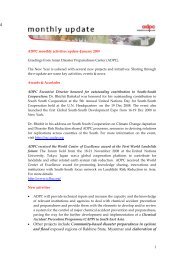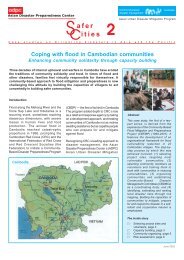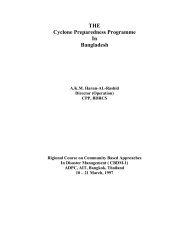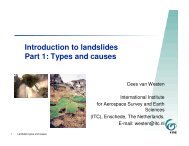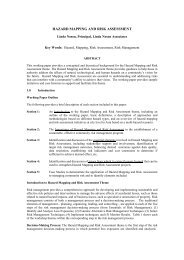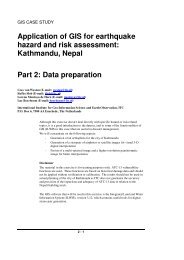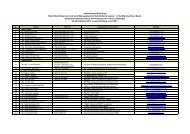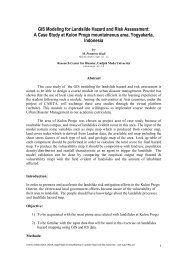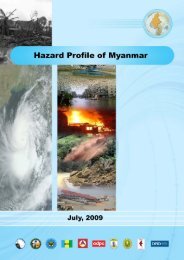community-based disaster risk management and the media media kit
community-based disaster risk management and the media media kit
community-based disaster risk management and the media media kit
Create successful ePaper yourself
Turn your PDF publications into a flip-book with our unique Google optimized e-Paper software.
chapter 3. useful information for <strong>the</strong> <strong>media</strong><br />
Community-<strong>based</strong> TSUNAMI Preparedness<br />
Tsunamis, also called seismic sea waves or incorrectly tidal waves,<br />
are caused generally by earthquakes, less commonly by submarine<br />
l<strong>and</strong>slides, infrequently by submarine volcanic eruptions <strong>and</strong> very rarely<br />
by large meteorite impacts in <strong>the</strong> ocean. Submarine volcanic eruptions<br />
have <strong>the</strong> potential to produce truly awesome tsunami waves. The Great<br />
Krakatau Volcanic Eruption of 1883 generated giant waves reaching<br />
heights of 40 meters above sea level, killing more than 30,000 people<br />
<strong>and</strong> wiping out numerous coastal villages.<br />
All oceanic regions of <strong>the</strong> world can experience tsunamis, but in <strong>the</strong><br />
Pacifi c Ocean <strong>and</strong> its marginal seas, <strong>the</strong>re is a much more frequent<br />
occurrence of large, destructive tsunamis because of <strong>the</strong> many large<br />
earthquakes along <strong>the</strong> margins of <strong>the</strong> Pacifi c Ocean.<br />
In <strong>the</strong> deep ocean, destructive tsunamis can be small - often only a<br />
few tens of centimeters or less in height – <strong>and</strong> cannot be seen nor<br />
felt on ships at sea. But as <strong>the</strong> tsunami reaches shallower coastal<br />
waters, wave height can increase rapidly. Sometimes, coastal waters<br />
are drawn out into <strong>the</strong> ocean just before <strong>the</strong> tsunami strikes. When this<br />
occurs, more shoreline may be exposed than even at <strong>the</strong> lowest tide.<br />
This major withdrawal of <strong>the</strong> sea should be taken as a natural warning<br />
sign that tsunami waves will follow.<br />
The Great Waves<br />
The phenomenon we call “tsunami” (soo-NAH-mee) is a series of<br />
traveling ocean waves of extremely long length generated primarily<br />
by earthquakes occurring below or near <strong>the</strong> ocean fl oor. Underwater<br />
volcanic eruptions <strong>and</strong> l<strong>and</strong>slides can also generate tsunamis. In <strong>the</strong><br />
deep ocean, <strong>the</strong> tsunami waves propagate across <strong>the</strong> deep ocean with<br />
a speed exceeding 800 kilometers per hour (~500 miles per hour), <strong>and</strong><br />
a wave height of only a few tens of centimeters (1 foot) or less. Tsunami<br />
waves are distinguished from ordinary ocean waves by <strong>the</strong>ir great<br />
length between wave crests, often exceeding 100 km (60 miles) or<br />
more in <strong>the</strong> deep ocean, <strong>and</strong> by <strong>the</strong> time between <strong>the</strong>se crests, ranging<br />
from 10 minutes to an hour.<br />
As <strong>the</strong>y reach <strong>the</strong> shallow waters of <strong>the</strong> coast, <strong>the</strong> waves slow down<br />
<strong>and</strong> <strong>the</strong> water can pile up into a wall of destruction tens of meters (30<br />
97



